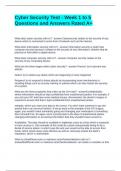Cyber Security Test - Week 1 to 5
Questions and Answers Rated A+
What does cyber security refer to? - answer Cybersecurity relates to the security of any
device which is connected to some form of network such as the internet.
What does information security refer to? - answer Information security is wider than
computer security because it relates to the security of any information, whether that be
physical or held within a digital device.
What does computer security refer to? - answer Computer security relates to the
security of any computing device.
What are the three stages within cyber security? - answer Prevent: try to prevent any
attacks
Detect: try to detect any attack which are happening or have happened
Respond: try to respond to those attacks by incorporating more mechanisms or
including things such as security training or policies which can also impact the security
of a system
What are the three properties that make up the CIA triad? - answerConfidentiality:
where information should be kept confidential from unauthorised parties. For example, if
you visit your GP and have some medical issues, documented, the doctor's surgery is
required to ensure that that is kept confidential from unauthorised parties.
Integrity: where you want your data to be correct. You don't want someone to go and
amend that in an incorrect fashion. If we go back to the example of the GP surgery,
again, you wouldn't want somebody going and changing your medication to something
that it shouldn't be. So again, we're coming back to the idea of unauthorised parties
changing information or accessing information that they shouldn't have access to.
Availability: The data should be available to legitimate users at a time which is expected
to have access to. One example of this could be a bank unexpectedly being hit by a
denial of service attack, in which case the end user would not be able to access their
funds, which could cause some distress as well as, obviously impact the bank's
reputation, which is undesirable.
What is a Bad/threat actor or malicious actor/hacker/attacker refer to? -
answerBad/threat actor or malicious actor/hacker/attacker: an insider or outsider so that
,is someone who is legitimately part of the system or someone who's external to that
who's trying to impose some form of harm on the system-- so to gain unauthorised
access to a system that it shouldn't have access to.
What does Malicious mean? - answerMalicious: where someone sets out with the intent
of causing harm.
What does non malicious mean? - answerNon-malicious: where someone
unintentionally compromises the security of the system-- for example, writing down a
password and storing it somewhere that can be easily found by someone who shouldn't
have access to that.
What is a vulnerability? - answerVulnerability: a limitation of a system which opens it up
to exploitation.
What is a threat? - answerThreat: something or someone which is constantly posing
potential harm to an asset, such as a data set.
What is an attack? - answerAttack: an attempted exploitation of a particular vulnerability
of a system.
What is an attack surface? - answerAttack surface: a collection of all the different points
of entry an unauthorised attacker could try to exploit.
What is an attack vector? - answerAttack vector: typically referred to after an attack has
taken place and is the particular path that the attacker has taken in order to gain
unauthorised access.
Give three examples of cybersecurity laws and regulations - answerComputer Misuse
Act, the Serious Crime Act Amendment which revised Computer Misuse Act to reflect
more modern landscapes, and the Data Protection Act 2018, which is the UK
implementation of GDPR.
Give four examples of cyber security events in history that changed the industry -
answerThe morris worm, phreaking 60s, first computer password, the 414s real life war
games, target 2013
What are cyber security frameworks? - answerCyber security frameworks are pre-
defined guides to developing security policies and procedures.
What is the purpose of cyber security frameworks? - answerThe aim is to reduce the
risk of common cyber security threats which organisations face on a daily basis.
Give three examples of cyber security frameworks - answerSuch frameworks are
generally defined by leading cyber security organisations like
,NIST (National Institute of Standards and Technology)
ISO (International Standards Organisation)
NCSC (National Cyber Security Centre)
What are the stages within the NIST cyber security framework? - answerIdentify,
Protect, Detect, Respond and Recover model
What is the common body of knowledge cyber security framework? - answerThe
Common Body of Knowledge (CBK) provides a knowledge base of information security
subjects, referred to as domains, a security professional should understand.
What are the ten security domains within the common body of knowledge? -
answerAccess Control Systems and Methodology
Telecommunications and Network Security
Business Continuity Planning and Disaster Recovery Planning
Security Management Practices
Security Architecture and Models
Law, Investigation, and Ethics
Application and Systems Development Security
Cryptography
Computer Operations Security
Physical Security
What are the stages within the ISO27001 cyber security framework? - answerPlan, Do,
Check, Act model
What does the NIST framework focus on? - answerassets, managing the risks related to
that, and detecting anomalies, incidents, response, and recovery.
What does the common criteria framework focus on? - answerThis applies more
specifically to the security of hardware and software products. The common criteria
applies only to system security. It's implementation independent, which means that it
doesn't prescribe particular controls.
Give three similarities that exist between all cyber security frameworks - answerThere
are similar families of objectives or areas of interest or function. They often rely on risk
management processes in terms of understanding the context, assets, threats, and
related processes.
They are often less specific in terms of implementation details. So they don't prescribe
particular controls that must be applied.
They all tend to have a review and reflection aspect to them. where we look at the
efficacy of our controls and countermeasures to continually improve our cybersecurity
processes and resilience.
, What is a cipher? - answerA cipher is effectively an algorithm which allows us to send a
message across an insecure network in a secure fashion. It means that if anyone were
to intercept that message, they would be unable to read the contents of that.
What are the three key components of a cipher? - answerPlain text: unencrypted
message that if anyone were to intercept that, they would be able to read it irrespective
of whether they have access to the key or not.
Key: the thing that allows us to apply the encryption. It's the secret information that
allows us to encrypt and potentially decrypt that information as well.
Cipher text: the result of applying encryption to the plain text using the key. The
intention here is that if someone was to send a message over an insecure network,
anyone intercepting that would not be able to read that message without the key.
Describe the cryptography analogy with the names Alice, Bob and Eve - answerThree
of the key names that you might hear in relation to cryptography include Alice, Bob, and
Eve. These are just traditional labels used to represent intended recipients, and the
sender, as well as someone trying to intercept that message. So Alice is sending a
message, Bob is receiving it or vice versa, and Eve is trying to intercept that message.
Describe the cryptography process - answerThe overall process when it comes to
ciphers is that we take our plaintext and we can apply our encryption algorithm using
the key and that results in our ciphertext. And then we can perform the reverse, the
decryption. We apply the decryption key to the ciphertext to get the plain text out.
The example that we have here, the key is basically a substitution where we're taking
every letter in English alphabet and translating that into a little diagram or figure if you
like.
What is the difference between symmetric and asymmetric cryptography? - answerThe
distinction here is down to the key that's being used for encryption and decryption.
Within symmetric cryptography, we've got the same key for encryption as we do for
decryption.
Within asymmetric cryptography, we have a different key for encryption and decryption.
What is a cryptographic primitive or hash? - answerA cryptographic primitive can be
considered a generic building block of cryptography.
Cryptographic primitives are a low level constructs which are used together to build
larger cryptographic protocols.
What is a cyrptographic hash function? - answerA cryptographic hash function takes
data of an arbitrary length, and produces a fixed length string of alphanumeric





